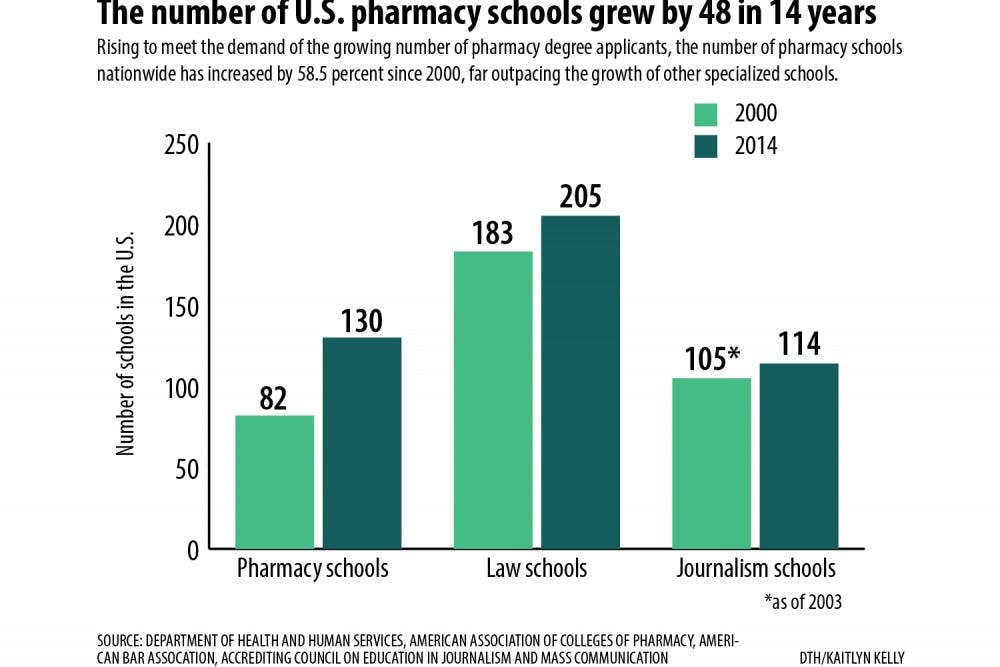In the 1990s, the aging population and the growing number of prescription medications increased the demand for pharmacists, and the industry feared a nationwide shortage. More than 5,900 full-time pharmacist jobs were vacant, and 98 percent of the country lived in states facing negative effects of the shortage, according to a 2000 Department of Health and Human Services report.
The Pharmacy Workforce Center, a nonprofit organization that studies the pharmacy profession, predicted a pharmacist shortage of 157,000 by 2020.
Employers began increasing pharmacists’ salaries and benefits hoping to fill their vacancies — a 2008 DHHS report said salaries had risen 6 percent a year for several years. The average annual wage was $116,500 in 2013.
High wages, benefits and job security enticed students into applying to pharmacy schools, and the number of schools rose to meet the increasing number of applicants. In 2000, there were 82 pharmacy schools in the United States. As of July 2014, there were 130.
A ‘changing’ job market
High Point University is planning on opening a pharmacy school as part of an expansion to its School of Health Sciences. It will be the fourth pharmacy school in the state, joining UNC, Wingate University and Campbell University.
Wendy Cox, assistant dean for professional education at the Eshelman School of Pharmacy, said the school has maintained a high job placement rate for its graduates.
“Students still have an ability to get a position,” she said. “When I first started, there may have been more positions out there in the more metropolitan areas such as Raleigh and Durham. Now it is a little more competitive and they may have to look for different opportunities, but there are still jobs out there.”
Michael Manolakis, assistant dean of student development at Wingate’s School of Pharmacy, said the current job market is part of the economy’s cyclical nature.
“The market today feels a lot like when I graduated in 1987,” he said.
“There weren’t open jobs in the urban areas, and you might be hired as a floater — going from one store to the next every week. It is important to be flexible; you need to be willing to possibly relocate for that first job.”
Both Cox and Manolakis said their school monitors graduates to make sure they are employed and adequately prepared for the job market. Neither has found recent graduating classes struggling to find employment.
To get the day's news and headlines in your inbox each morning, sign up for our email newsletters.
Cox said the job market for pharmacy school graduates is changing, and schools should ensure they are preparing students for jobs in addition to the traditional corner store.
“A lot of people think of pharmacy in the community realm such as CVS or Walgreens, but there are certainly a lot of opportunities,” Cox said. “They could work in hospitals or healthcare systems. They could work in research with different drug companies and at the Food and Drug Administration.”
Manolakis said the role of pharmacists has not changed and is still vital to the health care system.
“Getting patients access to and coverage for the services a pharmacist can provide is important,” he said. “We know when patients, especially those with chronic conditions, are monitored by a pharmacist closely, patient health improves.”
Cox said the Eshelman School of Pharmacy has implemented an updated curriculum for fall 2015, focusing on immersing students in patient care earlier in their studies.
“We are training our pharmacy students to be on the front lines of health care and interact with patients, immunize patients, take patient histories,” she said. “Not just for jobs that are existing now, but in the future as well.”
Ong said the job market is changing but still believes he will be able to find a job when he graduates.
“The field of pharmacy is becoming more saturated, but I don’t know what the outlook will be for me when I graduate,” he said. “I’ll just have to wait and see.”
state@dailytarheel.com




